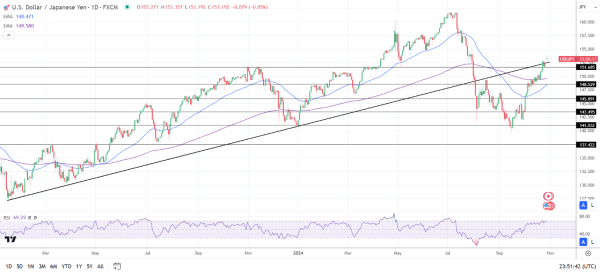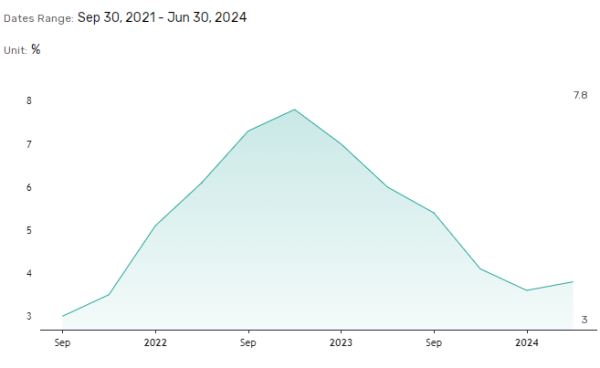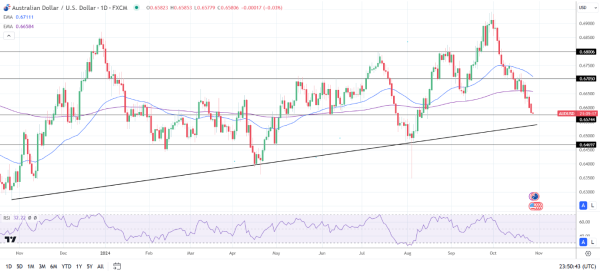Japanese Yen and Australian Dollar News: Japan’s Labor Market Tightens
Japan Labor Market Data Under Scrutiny
Japan’s labor market took center stage on Tuesday, October 29, influencing USD/JPY price trends.
Japan’s unemployment rate fell from 2.5% in August to 2.4% in September. The unexpected fall in unemployment could raise investor bets on a Q4 2024 Bank of Japan rate cut. Furthermore, the jobs/applications ratio increased from 1.23 in August to 1.24 in September.
Tighter labor market conditions and rising job adverts could boost wages, potentially fueling consumer spending and demand-driven inflation. A higher inflation outlook could increase speculation about a Q4 2024 Bank of Japan rate hike. A more hawkish BoJ rate path may drive the USD/JPY toward the 150 level.
The Bank of Japan Rate Path and the General Election
While the labor market data required consideration, the result of Japan’s general election continued to impact demand for the Japanese Yen. The Bank of Japan could abandon plans for monetary policy normalization if the LDP-Komeito coalition formed a majority government with parties favoring loose monetary policy.
However, negotiations may take days or weeks, potentially keeping the Bank of Japan on a cautious footing and the Japanese Yen on the back foot.
Japanese Yen Daily Chart
In the US session, attention shifts to the US labor market before Friday’s all-important US Jobs Report. Economists forecast JOLTs job openings to drop from 8.04 million in August to 7.99 million in September. A significant drop could fuel speculation about a weak US Jobs Report, potentially dragging the USD/JPY toward the crucial 150 level.
Meanwhile, consumer confidence trends could give insights into consumer spending plans. A pickup in consumer confidence could mitigate the effect of a soft JOLTs report.
Better-than-expected JOLTs job openings and an upswing in consumer confidence may push the USD/JPY toward 155, a key resistance level in Q3 2024.
Beyond the economic calendar, the upcoming US Presidential Election could influence the USD/JPY pair, especially with Donald Trump narrowing the poll gap with Kamala Harris.

RBA Monetary Policy in Focus Ahead of Looming Inflation Data
Investor focus could shift to Wednesday’s Aussie inflation data, which will likely impact RBA rate cut bets and the AUD/USD. Economists expect Australia’s inflation rate to fall from 3.8% in Q2 to 2.9% in Q3, potentially within the RBA’s target range of 2-3%.
Lower-than-expected inflation figures may fuel speculation of a November RBA rate cut. Rising bets on a Q4 2024 RBA rate cut could put the AUD/USD toward the crucial $0.65550 support level. Conversely, higher-than-expected numbers may temper bets on a Q4 2024 RBA rate cut, potentially driving the AUD/USD toward $0.66500.

While softer inflation numbers may fuel speculation about a November RBA rate cut, investors should consider the recent RBA press conference.
During the September press conference, RBA Governor Michele Bullock warned that headline inflation could come within the target range but may not reflect underlying inflation.
Expert Views on the RBA Rate Path
AMP Head of Investment Strategy and Chief Economist Shane Oliver recently gave his insights into RBA monetary policy, stating,
“Falling job vacancies & hiring plans evident in our Jobs Leading Indicator continues to point to slower jobs grth ahead. But for now the RBA will regard the jobs mkt as still tight, which on its own reduces the possibility of a rate cut by yr end. Our base case is Feb for first cut.”
Shane’s comments highlight the RBA’s challenges in bringing underlying inflation sustainably within its target range. Tight labor market conditions could continue to fuel consumption and demand-driven inflation.
Australian Dollar Daily Chart
In Tuesday’s US session, US consumer confidence and labor market data will influence US dollar demand. Higher JOLTs job openings and an uptick in consumer confidence may reduce bets on a December Fed rate cut. A more hawkish Fed rate path could pull the AUD/USD toward $0.65550.
Conversely, weaker-than-expected numbers could increase bets on multiple Q4 2024 Fed rate cuts, driving the AUD/USD toward $0.66500.
Aside from US economic indicators, US Presidential Election polls also require consideration. Rising support for Donald Trump could raise the risk of punitive tariffs on China, potentially impacting the Aussie economy and the Aussie dollar.

Stay ahead in the markets with our expert insights and real-time data analysis. Track real-time data, central bank views, and expert commentary to adjust your trading strategies accordingly.